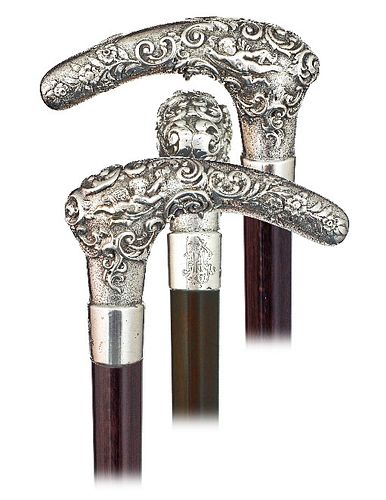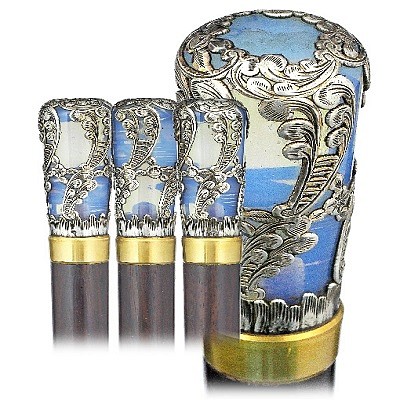Silver Dress Cane
Lot 25c
About Seller
Kimball Sterling
125 West Market Street
Johnson City, TN 37604
United States
Family-owned and family-run Johnson City Tennessee auction business for 25 years. Selling antiques and collectables for 38 years. Kimball M. Sterling, Inc. was founded and is owned by Kimball and Victoria Sterling, time and again, they have laid solid claim to world-wide attention and renown with an...Read more
Categories
About Auction
By Kimball Sterling
Oct 31, 2020 - Nov 15, 2020
Set Reminder
2020-10-31 00:00:00
2020-11-15 23:00:00
America/New_York
Bidsquare
Bidsquare : Canes and Walking Sticks
https://www.bidsquare.com/auctions/kimball-sterling/canes-and-walking-sticks-5893
Timed auction of canes and walking sticks Kimball Sterling kimballsterling@earthlink.net
Timed auction of canes and walking sticks Kimball Sterling kimballsterling@earthlink.net
- Lot Description
Ca. 1880-Large silver handle fashioned in a basic L-Shape with a slightly arched and tapering hand rest extending in a vertical stem attached to a plain and integral collar engraved with superbly intertwined “RF” initials. The handle itself is modeled in high relief, heavy cast and finely chased with two different, but matching panels, each showing a pudgy putto with a floating ribbon surrounded by rich Baroque scrolls and flower arrangements. It has the unique feature of a discreetly attached and useful custom ring under the handle to secure the cane with a tie band. Way out of the ordinary, this handle embodies the distinctive Viennese taste and recreates the aesthetic impact of that great period. Furthermore, it attests to the virtuosity of the Viennese silversmith as it survived brilliantly the test of time and is graced by a snake wood shaft and a Siam horn ferrule. Notable is that cast handles required in their manufacturing greater skill and time than the embossed ones, consequently by far more expensive and definitely more durable. H. 4 ½” x 3 ¼”, O.L. 34 ½” Putto, plural putti, a nude chubby child figure, often with wings, frequently appearing in both mythological and religious paintings and sculpture, especially of the Renaissance and Baroque periods. Derived from personifications of love, or Eros figures, in Greek and Roman art, putti came to be used to portray cherubim in Italian paintings from the Renaissance onwards. With the revival of classical mythological subjects in the arts, Cupid was commonly represented as a putto, and numbers of anonymous putti were frequently depicted in attendance on various immortals. Generally speaking, Putti represent tender passion and loving affection. Piratinera Guianensis or snake wood belongs to the family of Moraceae and originates in tropical South AmeriCa It is a truly exotic species and probably one of the most difficult woods to find. Typically, it is a very small tree, and only shows the wonderful reddish brown heartwood with speckles of black appearing as hieroglyphics or snakeskin markings in a small quantity of the wood, and then rarely evenly spread across the entire face of the board. Its markings which resemble those of a snakeskin, give this small, relatively rare timber its name. Snake wood is dense, extremely heavy and hard, brittle and splits easily. It becomes very smooth when finished and has natural polish.
- Shipping Info
-
Each auction has different shipping terms but the buyer always pays.Canes:After payment has been received we will ship in-house the domestic orders, International bidders will be shipped by the UPS store (423-979-7122) and email store4146@theupsstore.com After we receive payment we will deliver to the UPS store and they will contact you.Other Auctions:After payment has been received and cleared we will deliver your items to the UPS Store and they will quote and prepare for shipping.phone (423-979-7122 and email store4146@theupsstore.com
-
- Buyer's Premium



 EUR
EUR CAD
CAD AUD
AUD GBP
GBP MXN
MXN HKD
HKD CNY
CNY MYR
MYR SEK
SEK SGD
SGD CHF
CHF THB
THB



















